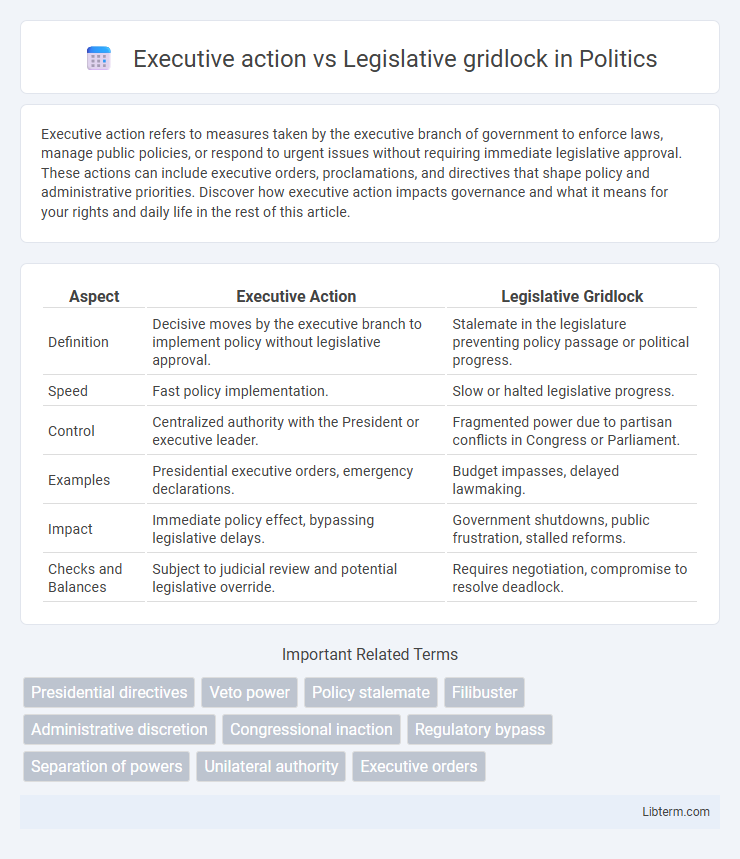Executive action refers to measures taken by the executive branch of government to enforce laws, manage public policies, or respond to urgent issues without requiring immediate legislative approval. These actions can include executive orders, proclamations, and directives that shape policy and administrative priorities. Discover how executive action impacts governance and what it means for your rights and daily life in the rest of this article.
Table of Comparison
| Aspect | Executive Action | Legislative Gridlock |
|---|---|---|
| Definition | Decisive moves by the executive branch to implement policy without legislative approval. | Stalemate in the legislature preventing policy passage or political progress. |
| Speed | Fast policy implementation. | Slow or halted legislative progress. |
| Control | Centralized authority with the President or executive leader. | Fragmented power due to partisan conflicts in Congress or Parliament. |
| Examples | Presidential executive orders, emergency declarations. | Budget impasses, delayed lawmaking. |
| Impact | Immediate policy effect, bypassing legislative delays. | Government shutdowns, public frustration, stalled reforms. |
| Checks and Balances | Subject to judicial review and potential legislative override. | Requires negotiation, compromise to resolve deadlock. |
Understanding Executive Action: Definition and Scope
Executive action refers to the powers and measures taken by the President or executive branch to implement laws, manage operations, and address urgent issues without awaiting legislative approval. This scope includes executive orders, proclamations, and regulations that direct federal agencies and influence national policy swiftly. Understanding executive action is crucial for distinguishing how the executive branch can bypass legislative gridlock to enforce decisions and initiate change effectively.
The Nature of Legislative Gridlock
Legislative gridlock occurs when political parties or branches of government are unable to reach consensus, resulting in stalled lawmaking and policy implementation. This impasse often stems from ideological polarization, competing interests, and strategic obstruction within legislatures. Such deadlock hampers effective governance, prompting executives to resort to unilateral actions to bypass legislative inaction.
Historical Context: Executive Orders in U.S. Politics
Executive orders have historically served as critical tools for U.S. presidents to bypass legislative gridlock and implement policy unilaterally, especially during times of divided government or congressional inaction. Notable examples include Abraham Lincoln's Emancipation Proclamation and Franklin D. Roosevelt's New Deal directives, highlighting the executive branch's ability to address urgent national issues without waiting for congressional approval. This practice underscores the ongoing tension between executive authority and legislative control within the American political system.
Key Differences: Executive Action vs Legislative Lawmaking
Executive action allows the President to implement policies swiftly through orders, memoranda, and directives without requiring Congressional approval, providing flexibility during legislative gridlock. Legislative lawmaking involves a formal process where laws are proposed, debated, and approved by both houses of Congress, ensuring broader consensus and democratic checks. The key difference lies in executive action's unilateral nature versus the collaborative and deliberative nature of legislative lawmaking.
Causes of Congressional Gridlock
Congressional gridlock primarily results from deep partisan polarization, where opposing political parties struggle to reach consensus on key policy issues. The increasing ideological divide among legislators, amplified by factors such as gerrymandering and primary election incentives, limits bipartisan cooperation and legislative productivity. Complex committee structures and procedural rules like the filibuster further exacerbate stalemates, preventing timely legislative action and prompting executive actions as alternative policy tools.
Impact of Gridlock on Policy Outcomes
Legislative gridlock significantly hampers policy outcomes by stalling critical bills and delaying necessary reforms, often leading to inefficiencies and unmet public needs. Executive action becomes a crucial tool to bypass these impasses, enabling the implementation of regulations and emergency measures without congressional approval. This shift can streamline decision-making but also raises concerns about the concentration of power and the circumvention of democratic processes.
Presidential Powers: Limits and Legal Challenges
Presidential powers allow executive action to bypass legislative gridlock, enabling swift policy implementation through executive orders and directives. However, these powers face constitutional limits, as courts can invalidate actions that exceed statutory authority or infringe on separation of powers principles. Legal challenges often focus on the scope of executive authority, with landmark cases like Youngstown Sheet & Tube Co. v. Sawyer defining boundaries to prevent executive overreach.
Notable Examples of Executive Action Amid Gridlock
Notable examples of executive action amid legislative gridlock include President Barack Obama's use of executive orders to advance immigration reform, such as DACA, when Congress failed to pass comprehensive immigration legislation. President Donald Trump frequently leveraged executive orders to implement key policy changes on immigration, trade, and deregulation without congressional approval. These actions demonstrate how presidents utilize executive authority to bypass legislative stalemate and achieve policy goals.
Public Perception: Trust in Executive vs Legislative Branch
Public perception often favors executive action during legislative gridlock due to its ability to deliver prompt decisions and visible results. Trust in the executive branch tends to rise when Congress is perceived as ineffective or deadlocked, highlighting frustration with partisan stalemates. However, sustained reliance on executive actions may eventually erode democratic accountability and public confidence in institutional checks and balances.
The Future of Governance: Balancing Authority and Accountability
Executive action offers a swift mechanism for policy implementation during periods of legislative gridlock, where congressional disagreement stalls lawmaking and hinders government responsiveness. This dynamic raises complex questions about balancing the concentration of executive authority with the imperative for democratic accountability, ensuring decisions reflect public interest without bypassing representative processes. Future governance strategies must refine institutional checks and promote transparent executive-legislative collaboration to uphold effective, accountable leadership amid political polarization.
Executive action Infographic

 libterm.com
libterm.com